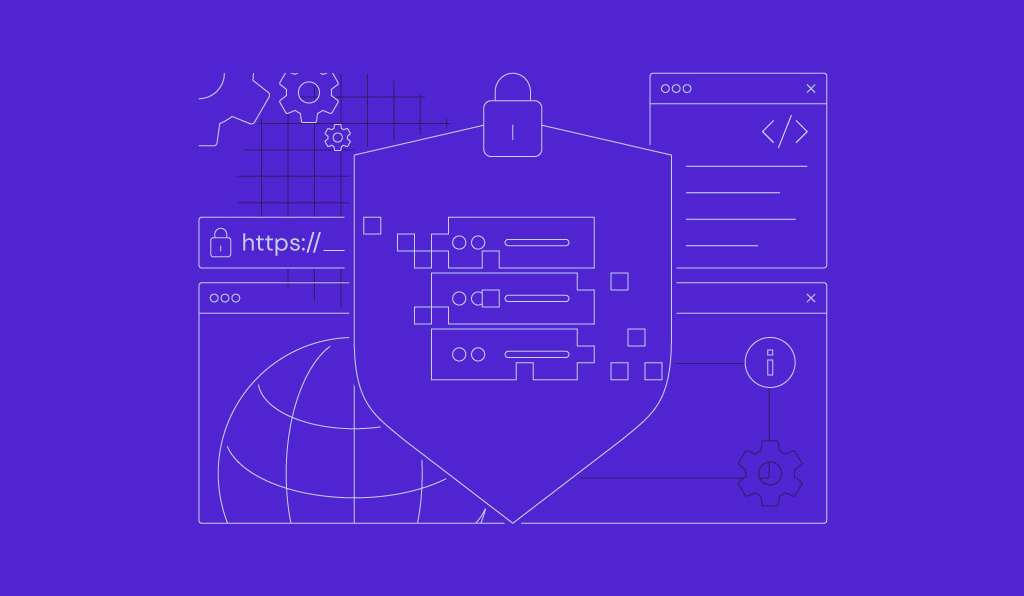What Is Container Orchestration, How It Works, and How to Use It With Orchestration Tools

Container orchestration has become a critical tool in modern software deployment. It streamlines managing, scaling, and maintaining containerized applications in dynamic environments.
This article will explain what container orchestration is, how it works, and its benefits. We’ll also explore its role in virtual environments and review the top container orchestration tools for optimizing deployment processes.
Download Free Docker Cheat Sheet
What Is Container Orchestration?
Container orchestration is an automated management of container lifecycles, streamlining tasks such as scaling, maintenance, deployment, and network configuration in hosting environments.
This technology ensures that the proper containers run at the right times, use resources efficiently, and communicate effectively with other containers.
Implementing container orchestration tools allows developers and system administrators to handle complex container setups, scale them as needed, and achieve resilience and high availability.
Moreover, container orchestration automates the entire container’s lifecycle based on its specifications, from initial deployment to end-of-life management. It maintains a balance between optimal resource management and performance requirements.
What Is Containerization?
Containerization holds an application and its dependencies within a container. Unlike traditional virtualization, which relies on separate operating systems for each virtual machine (VM), containerization allows multiple containers to share the same OS kernel.
While virtualization is ideal for scenarios requiring complete OS isolation, such as running complete systems or specific legacy applications, containerization is favored for applications requiring rapid deployment and scalability.
Containers boast lower performance overhead, notably in startup time and resource efficiency, leading to more effective resource use. They also facilitate faster deployment cycles, crucial for adapting to market demands, and enhance scalability for varying workloads.
Moreover, containerization ensures consistency across different stages, from development to production. This consistency reduces the discrepancies often encountered when moving container-based applications between environments.
Docker has become synonymous with containerization. It provides a standardized format for containerized apps and an ecosystem for efficiently managing containers, suitable for microservices architectures.
How Does Container Orchestration Work?
Container orchestration works by managing containerized applications through a declarative configuration model. This process relies on critical principles like load balancing and self-healing.
Load balancing distributes container workloads evenly, ensuring no single container or node is overwhelmed. This approach maintains optimal performance and resource utilization.
Self-healing mechanisms are designed to automatically detect and rectify issues, such as container or cluster failures. When encountering failed containers, the orchestration system promptly replaces them, minimizing downtime and ensuring continuous operation of the application.
The orchestration architecture consists of master nodes orchestrating the container environment and worker nodes executing the containers.
Configuration files, usually in YAML or JSON format, are essential. A configuration file defines the applications’ desired state, including container images, resource allocation, and network settings.
A practical application of orchestration is in managing web applications during high traffic. The system dynamically adjusts, adding containers to handle increased load and scaling down as needed, ensuring resource efficiency and consistent performance.
Benefits of Container Orchestration
Here are some significant benefits of container orchestration in the modern computing environment:
Scale and Use Resources Efficiently
Container orchestration excels at scaling applications through horizontal and vertical methods.
- Horizontal scaling, often the more common approach in a containerized environment, involves adjusting the number of container instances in response to current demand. This flexibility allows for rapid scaling as needed.
- Vertical scaling refers to adjusting the processing and memory resources allocated to each container. While it may be less flexible than horizontal scaling, it is suitable for resource-intensive applications.
Automating these processes is a crucial benefit of orchestration, particularly in efficiently allocating resources for each scalable container in virtual private server (VPS) environments.
Additionally, the lightweight nature of containers allows more instances to run on the same server, maximizing hardware utility and reducing operational costs. This efficiency is vital for cost-effective VPS management and performance enhancement.
Enhance Security and Isolation Between Containers
Container orchestration significantly boosts security and isolation within containerized environments. By keeping applications in separate containers it creates barriers that limit interactions among them.
Container orchestration platforms are also pivotal for enforcing security policies and automating compliance. They implement uniform container security measures, reducing vulnerabilities and aligning with industry-specific regulations, which is crucial in sectors like finance and healthcare.
Moreover, container orchestration tools help in storing log data for monitoring, security auditing, and troubleshooting.
The combination of isolation, automated security, and compliance adherence through orchestration tools results in a secure, resilient, and compliant distributed environment. This is vital for maintaining high availability and robust security in container orchestration systems.
Automate and Simplify Deployment Processes
Container orchestration revolutionizes application deployment by reducing complexity and minimizing human errors, which are common causes of deployment issues.
An essential advancement is the facilitation of customized deployment strategies, notably blue-green deployments and canary releases, which many container orchestration tools manage adeptly.
In blue-green deployments, two identical production environments are maintained, but only one is active at any given time. On the other hand, canary releases involve gradually rolling out a new version to a small subset of users before broader distribution.
This shift from manual to automated systems allows teams to concentrate on strategic project aspects, enhancing the reliability and efficiency of deployment processes. This transformation drives application development toward greater efficiency and reduced error susceptibility.
Implement Continuous Integration and Continuous Deployment (CI/CD) in Orchestration
CI/CD, integral to modern software development, brings frequent, automated updates to applications. Using CI/CD in container orchestration significantly enhances the development and deployment pipeline.
An orchestration tool can enable real-time updates, robust version control, and efficient rollback processes. They seamlessly integrate into the CI/CD pipeline, facilitating continuous integration, testing, and deployment of code changes.
A key advantage is the ability to roll back to stable versions swiftly. If new deployments encounter issues, the orchestration system can revert to a previously stable version of the application.
In DevOps, where software development and IT operations converge to expedite the development lifecycle, the fusion of CI/CD with container orchestration enables rapid, high-quality software delivery.
This synergy enhances the speed, stability, and reliability of software releases, aligning them with the dynamic needs of businesses and users.
Using Container Orchestration With Virtual Private Servers (VPS)
Integrating container orchestration with the best VPS providers enhances server environment efficiency and reliability. VPS container optimization streamlines deployment and management, ensuring effective resource utilization and improving overall performance.
For instance, a gaming company using orchestration can automatically adjust game server instances to match player activity. It can scale up during busy hours and down during quieter times for optimal resource usage and a seamless gaming experience.
Furthermore, container orchestration in VPS hosting is wider than in single-cloud environments. It facilitates multi-cloud strategies, significantly increasing flexibility and scalability across various cloud platforms.
This flexibility lets businesses avoid vendor lock-in or optimize containerized workloads across multiple cloud providers for cost, compliance, or performance reasons.
In multi-cloud setups, orchestration tools allow seamless container management and migration between cloud services, leveraging each provider’s unique advantages, such as location, specialized services, or cost benefits.
Additionally, a multi-cloud container orchestration platform simplifies operations, offering a cohesive approach to managing diverse cloud resources.

Container Orchestration Tools
Choosing the right container orchestration tool depends on scalability, ease of use, and application-specific needs. Here are three notable tools:
Kubernetes
Kubernetes is a container orchestration tool widely recognized for its capability to support large-scale, complex deployments. Initially developed by Google, it is now maintained by the Cloud Native Computing Foundation.
This orchestration tool manages container clusters across multiple operating system hosts via a container orchestration engine. It offers features such as automatic bin packing, self-healing, traffic routing, and service discovery, which are suitable for running Linux containers and other OCI-compliant container types.
Kubernetes orchestration is particularly well-suited for cloud-native application development that requires efficient container scaling, though its extensive functionality may result in a steep learning curve.
Docker Swarm
Docker Swarm is an open-source platform for smaller setups in Docker container orchestration. It simplifies container clustering of Docker hosts, effectively transforming them into a single virtual host.
This container orchestration tool is also integrated with Docker Engine to provide a streamlined container running experience. While not as feature-rich as Kubernetes, its simplicity suits teams familiar with Docker orchestration and does not require advanced functionalities.
Amazon ECS
Amazon Elastic Container Service (ECS) is a high-performance container orchestration service for Docker containers, enabling easy running and managing of containerized software on AWS at scale.
ECS removes the need to install and operate your container orchestration software and manage multiple clusters on virtual machines. Especially suitable for AWS-centric environments, it offers a simpler setup than other container orchestration tools like Kubernetes.
| Feature | Kubernetes | Docker Swarm | Amazon ECS |
| Core strength | Complex container-based deployments | Simplicity and Docker integration | AWS integration, ease of use |
| Ease of use | Steep learning curve | User-friendly, easy to set up | Simplified for AWS |
| Integration | Broad ecosystem, cloud-native orchestration | Seamless with Docker environment | Deep AWS services integration |
| Use case | Large-scale, cloud-native apps | Small to medium deployments, Docker-based setups | AWS-based container deployments |
| Scalability | High scalability | Moderate scalability | High scalability in AWS environment |
| Community support | Extensive, with a large community | Good, mainly within the Docker community | Strong, within the AWS ecosystem |
When selecting a container orchestrator, consider the community and support ecosystem, especially for open-source container orchestration solutions. These resources provide invaluable support and knowledge sharing.
Additionally, mastering basic Linux commands is essential, as it lays the groundwork for effectively managing and interacting with container orchestration systems.
Conclusion
Container orchestration is integral to modern web application architecture, enhancing containerized environments’ efficiency, security, and manageability.
With its ability to deploy and manage containers automatically, container orchestration is vital in optimizing server performance and reliability, particularly in virtual server environments.
Adopting container management tools aligns with technological progress and transforms the landscape of web application development and management, setting new standards in the field.

